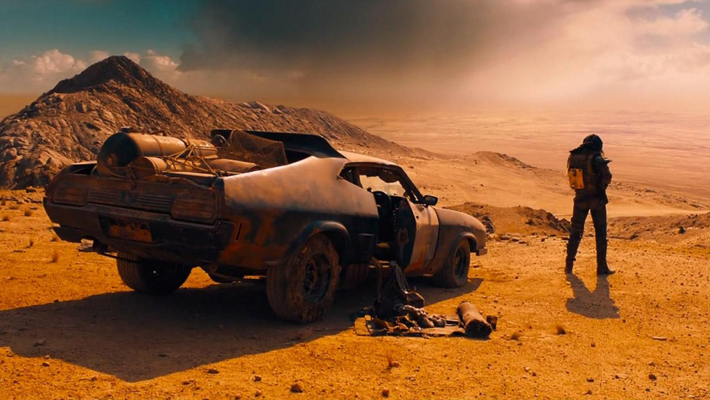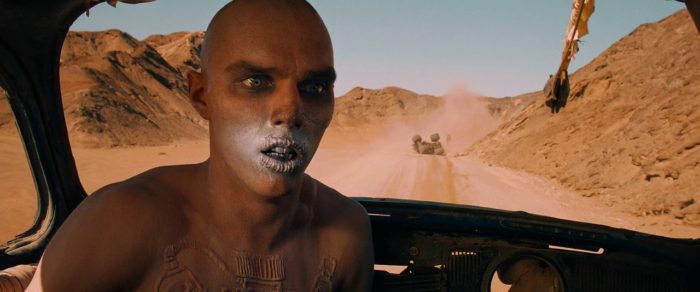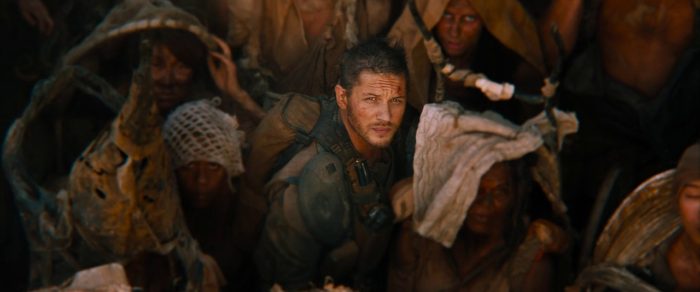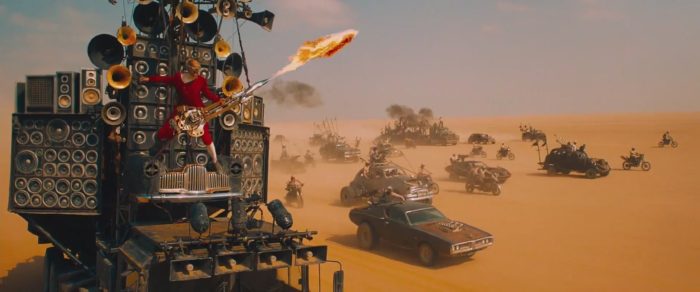How is a car-chase action sci-fi film a visual rhetoric masterpiece? Exhibit “A”: Mad Max: Fury Road.
Film has always been a great love of mine, despite the critical lens I tend to put on it. To lighten my critic’s mood, today I want to discuss something really close to my heart. Science fiction has been my jam since I was a little strawberry, and sci-fi action flicks were the first films I watched that I ever gave multiple viewings. Yet, the more film-intelligent I became, the more I wished my first loves could always be as deep and rhetorically artistic like other films. Because, let’s be honest, Resident Evil and Underworld may be fun, bloody, and badass, but not exactly masterpieces of cinema. And the ones that were artistic and brilliant tended to lack on that badass edge that first brought me to the bright excitement of science fiction.
Then came Mad Max: Fury Road.
Now, this clearly wasn’t the first rhetorically stimulating sci-fi action film. Movies like District 9 and Inception are pretty action packed and still thought-provoking and complex. But Mad Max: Fury Road was a different monster to me. I was enrapt. But why?

Because the rhetoric was largely only visual, and the dialogue in the movie was very sparse. Yet it was still very clever and well done, and I felt so mentally stimulated, and also into the action because of that. District 9, Inception, and others took several viewings because the first viewing’s attention would be largely on plot and action, and then more viewings would contain the rhetoric.
However, I could feel all the rhetoric teeming on the screen the first time through Mad Max: Fury Road, even if I wasn’t always attune to all of it. It was amazing. I’ve watched the movie at least 3-4 other times, and it’s been just as wonderful each time. It’s like each corner of the screen has something of interest in it.
So, beyond my fangirling, why do we care?
Well, it seems that most sci-fi action films fall into two camps: mind-benders or badass junction. The mixing is rare. See, mind-benders have badass moments, but other than their 2-3 badass moments, it’s pretty solely focused on philosophy, theories, and the characters. Badass junction films have very few character scenes, and even less with any philosophical, thought-provoking meaning, but a lot of intense and exciting action and fighting.
Mad Max: Fury Road is one of the few, beautiful love children of the two camps. And I absolutely adore every minute of it.
Now, as I mentioned previously, Mad Max: Fury Road accomplishes this blend of badass and mind-bending through its extremely intent, masterful, and clever uses of visual rhetoric. But, as everyone may not have studied the topic, let’s give a brief, friendly overview. Visual rhetoric is the art of using very specific visuals to elicit very specific thoughts and connections in viewers’ brains. A super easy and common one is the use of ravens to signify death or a bad omen. Funnily enough, Mad Max: Fury Road even uses this really common one when foreshadowing the death of one of the antagonists. Although some are simple like the raven, others are more complex and take some time to think about, but still make you infer associations in the story without saying a word.
So without furthering ado, here are prime examples of Mad Max: Fury Road’s visual rhetoric excellence.

One of my favorite examples, and also I believe to be one of the strongest, is the use of mask imagery in the film. If you look for the imagery through the work, there is a plethora. The war boys and Furiosa all have black marring their eyes, like a small face mask. Immortan Joe wears a giant face mask, blocking his mouth. during the first act of the movie, Max also wears a mask over his mouth until the fight on top of the oil rig. The base effect of the mask symbolism is simple: people hiding their real selves behind imposing masks. Furiosa and the war boys are hiding the more vulnerable human behind their tough personas as underlings for Immortan Joe. The more Furiosa reveals her closeness to the wives and her desire to find her way home, the more her black-eye mask fades away. By the end of the film, her face is clear and she shows true emotion and humanity. Immortan Joe, dissimilarly, uses his mask to increase his intimidation factor and make him look like a fierce, immortal leader. However, once the mask is removed, he is simply an old, crippled man clawing his way over others to obtain his cruel power. And Max, our titular character, has my favorite of the mask transformations. Max wears a mask the first act of the movie, haunted by the people he has tried to protect and save throughout the years and being cut off slowly from humanity and becoming more and more mad. He also is solely focused on surviving, but once he makes the conscious effort to help protect others, such as Furiosa and the wives, his mask is ripped off, and the more humane hero in Max is revealed. The point is, no matter how mad Max gets, deep down he is a heroic person who will always work to help save others. Therefore, through the multiple uses of the imagery, it not only creates singular character rhetoric, but also an overarching film rhetoric of how people wear masks in this new world to survive, but underneath are all still humans struggling in a barren, brutal world.

And on the note of that brutal world, the movie also tells the entire background of the war boys without saying much about it verbally. Throughout the entire first act, through visuals and scenery, we discover how war boys are not only relatively unhealthy (a constant need for human blood bags, pale, sickly skin) but also indoctrinated by Immortan Joe from a young age to be his personal henchmen (their suicidal tendencies for the sake of war, the reverence of Valhalla, their craving for Joe’s approval, the child war boys around the entire complex working as slaves). Barely anything is told directly about them, but you learn copious amounts of information concerning them without having to get an exposition trash pile dumped on you. This is used here with a lot of other elements in the movie, conveying a lot of information but not overwhelming a viewer with someone sitting down and telling you all of it. It sets up the movie to have more space for the badass action mentioned earlier while still saying a lot about deeper topics, like with the masks and other symbolic devices.
I could go on and on forever about even more of these imageries and visual rhetorics, particularly with characters like Knux and centered on Max even though he barely speaks, but you get the point. Instead, I’ll proceed to my conclusion.

Through the employment of these visual rhetoric practices and the non-verbal cues that help explain the exposition, Mad Max: Fury Road pulls off being a rare gem full of wild, badass action scenes, yet also remaining full of moments that are slower and truly get a viewer to think about the topics discussed. I get to love brutal chase scenes and flaming guitar guys while also thinking profoundly when one of the wives, The Dag, contemplates the future of her child being the son of a monster, and Knux quietly dying just for the red-haired wife, Capable, because of the first true, human bond he has grown. There is a bright, flaming violence to the movie, but also a quieter beauty. Its an eclectic film and, in my personal opinion, a masterpiece in its great use of visual rhetoric and balance of all its wonderful elements. Mad Max: Fury Road has helped change the way I look at films, and has raised the bar for good action films. A movie can be a fun watch and also brilliant. Gargantuan explosions can be beautiful, inside and out.
